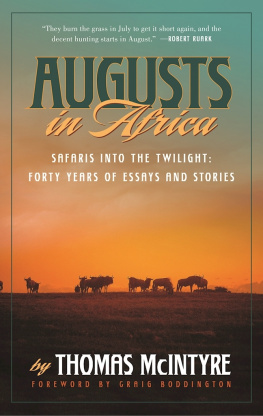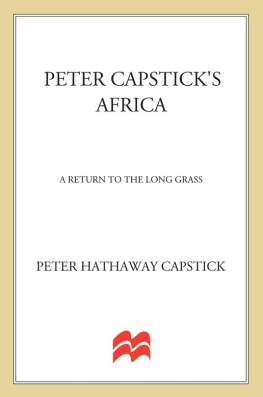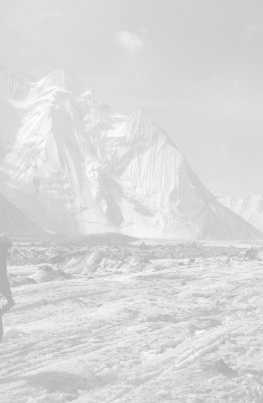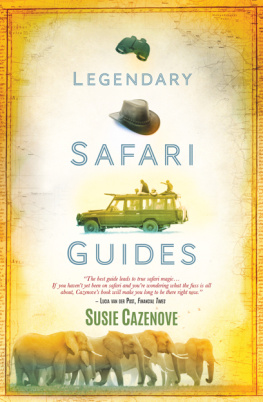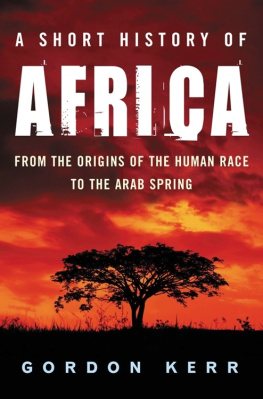Copyright 2016 by Thomas McIntyre
Foreword copyright 2016 by Craig Boddington
Illustrations copyright 2016 by Andrew Warrington
All rights reserved. No part of this book may be reproduced in any manner without the express written consent of the publisher, except in the case of brief excerpts in critical reviews or articles. All inquiries should be addressed to Skyhorse Publishing, 307 West 36th Street, 11th Floor, New York, NY 10018.
Skyhorse Publishing books may be purchased in bulk at special discounts for sales promotion, corporate gifts, fund-raising, or educational purposes. Special editions can also be created to specifications. For details, contact the Special Sales Department, Skyhorse Publishing, 307 West 36th Street, 11th Floor, New York, NY 10018 or .
Skyhorse and Skyhorse Publishing are registered trademarks of Skyhorse Publishing, Inc., a Delaware corporation.
Visit our website at www.skyhorsepublishing.com.
10 9 8 7 6 5 4 3 2 1
Library of Congress Cataloging-in-Publication Data is available on file.
Cover design by Chuck Cole
Cover photo by Thomas McIntyre
Print ISBN: 978-1-5107-1397-0
Ebook ISBN: 978-1-5107-1401-4
Printed in the United States of America
Did you ever think about going to British East Africa to shoot?
No, I wouldnt like that.
Id go there with you.
No; that doesnt interest me.
Thats because you never read a book about it.
The Sun Also Rises
My opinion of traveling is brief: When traveling, do not go too far, or you will see something that later on will be impossible to forget.
Daniil Kharms

Contents


Foreword

I suppose a great writer might approach every piece with the thought that its the most important thing he or she has ever written. I suspect thats the way Thomas McIntyre approached this book, but I cannot know for sure, because I am not and have never been a great writer and thus, now 60-something, am somewhat unlikely to become one. One might describe me kindly as a decent reporter and perhaps not a bad storyteller, but a gifted writer I am not. So I tend to approach writing assignments pragmatically, somewhat like planning and conducting a military operation, something I was once considered fairly adept at. The steps are simple: assess, plan, proceed, with the first, at least theoretically, ongoing.
My assessment: This is an important book by a gifted writer. My plan: To relate why, and, along the way, explain why I am significantly honored to pen this foreword for my old friend, colleague, and occasional competitor, Tom McIntyre. So lets proceed.
The body of literature we call Africana has yielded the richest treasure trove in the entire world of sporting literature. At one time it was rivaled by the wonderful stuff written about the great game of the Indian subcontinent, but the days of the Raj are long over. Partition of India and Pakistan separated the mountains and deserts from the forests and jungles, and modern Indias burgeoning human population has left little room for wildlife and none for hunting. Pursuit of Indias great gametiger, leopard, gaur, sloth bear, sambar, and so much morehas faded into dimming memory. A full generation has passed since a significant sporting book has come from that region, and there will be no more.

One might argue that, today, Africas wildlife is similarly slipping away. In one sense this is true: Overpopulation, meaning encroachment by agriculture and livestock and resultant habitat loss, is pushing Africas wildlife into ever-shrinking protected enclaves. Sadly, today there are huge expanses of Africa holding virtually no wildlife, and the concept of wild Africa is increasingly elusive. That said, Africa is a very big place. Much wild game remains, in some cases more than what Tom and I first saw more than 40 years ago.
You see, protection can and does take at least two distinct forms in Africa. Lets understand that in Africas developing economies there is little room and no money for altruism. Wildlife must somehow pay its own way, or must give way to villages, herdsmen, and plows. Some of those protected enclaves are national parks, the most famous and scenic of which are well-funded by an active photo safari (ecotourism) industry. Regrettably, the total acreage of Africas parks reflects just a tiny percentage of a mighty land mass. Most of the rest of Africa that actually retains viable wildlife, though larger, is also not a major percentage of the whole. However, surprising though it might be to non-hunters and infuriating to anti-hunters, outside of the national parks, most areas that still hold significant wildlife reserves are protected by hunting and hunters.
This takes at least two paths in modern Africa. On the southern tip of the continent much wildlife is privatized, brought to market as a cash crop monetized in breeding stock, venison, and harvesting by (mostly foreign) sport hunters. The success of the game ranching industry is such that wildlife in South Africa alone has burgeoned from a few hundred thousand head in 1970 to an estimated 17 million today. Namibia is a similar success story.
Elsewhere on the continent the road is bumpier, but large areas ranging from designated game reserves to government and tribal concessions are purely looked after by hunters dollars. Lets accept that much of this is marginal land, lacking the beauty and species diversity of Africas great parks. As such, ecotourism in significant volume is not viablebut hunting is, because we crazy hunters willingly place ourselves in marginal lands, working hard, sweating much, and paying dearly for the possibilitynever the certaintyof harvesting a handful of Africas legendary beasts. Our currency funds the game departments, such as they are, but, more importantly, at the local level, creates employment, distributes legally taken meat, sinks wells, builds clinics and schools, and funds anti-poaching efforts, much of which today are conducted not by governments, but by safari operators who probably have the most to lose.
There is much to be optimistic about regarding African wildlife and African hunting. The hunting safari industry is bigger than ever. At this writing, fully 20 African nations use some form of regulated sport hunting both as a management tool and to generate revenueplacing value on wildlife. This is many more potential destinations than when Tom and I first hunted Africa in the 1970s. The African continent hosts nearly 20,000 hunting safaris annually, a far greater number than ever before. A majority of these are the modern short-duration plains game safari, an option that didnt even exist when Tom and I were young. These affordable safaris have opened African hunting to people from all walks of life. Thousands of new hunters realize their dreams of Africa every year. Since planning an African safari is a bit more complex than applying for an elk tag, it means that many thousands more are dreaming of that life-changing first safari. And, I can assure you, any hunter who has visited Africa once is ruined forever, and will spend the rest of his or her life dreaming, planning, and hoping to return.

